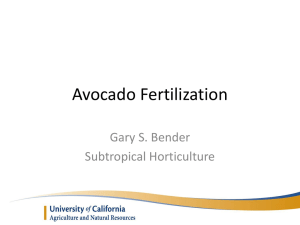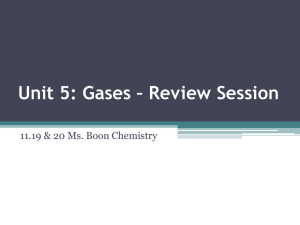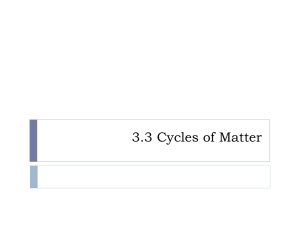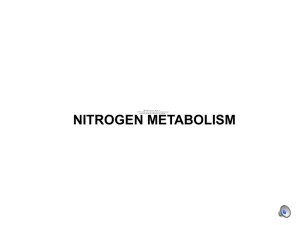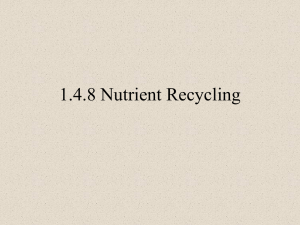Principles of Environmentally
advertisement
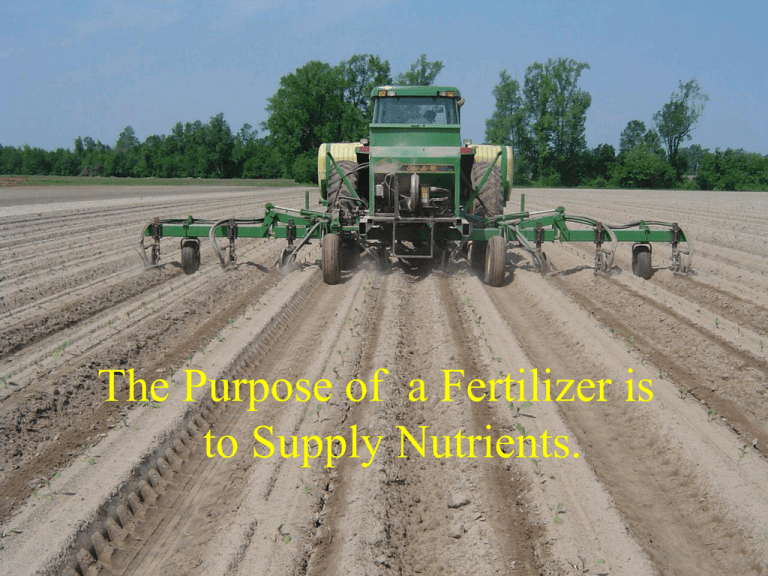
The Purpose of a Fertilizer is to Supply Nutrients. Tobacco Fertilization • Not only important for optimum yield, but extremely important for quality • Ripenning of tobacco is caused by N starvation • Begins with the bottom leaves (same as N deficiency) and moves up the stalk • Proper fertilization is key to ripenning Fertilization Principles • Understand the nutrient needs of the plant. • Know the level of nutrients supplied by the soil. • Use fertilizers to supply the difference. • Lime to the optimum pH. Soil Testing • • • • Before any fertilizer is applied P index K index pH Effect of pH on Nutrient Availability Troug, 1948 The pH of Tobacco Soils in the Coastal Plain and Piedmont 45 40 35 30 25 Coastal Plain Piedmont 20 15 10 5 0 0-4.9 5-5.4 5.5-5.9 6.0-6.4 6.5+ 2002 Recommended pH • For Tobacco Soils – 5.8 to 6.2 Essential Elements • Carbon, Hydrogen, Oxygen • Nitrogen, Phosphorus, Potassium, Calcium, Magnesium, Sulfur, Chloride • Boron, Manganese, Iron, Zinc, Copper, and Molybdenum Nutrient Removal by a 2000 Pound Tobacco Crop Nutrient Pounds/Acre Nitrogen 70 Phosphorus 12 Potassium 80 Calcium 55 Magnesium 22 Sulfur 18 McCants and Woltz Nutrient Removal by a 2000 Pound Tobacco Crop Nutrient Pounds/Acre Boron 0.07 Manganese 0.7 Iron Trace Zinc Trace Copper 0.04 Molybdenum Trace McCants and Woltz Fertilization Principles (The Five R’s) • • • • • Apply the right nutrient, at the right rate, at the right time, in the right place, at the right cost. Effect of Base Fertilizer Application Methods on Yield 2360 2340 2320 2300 Lb/A 2280 Yield 2260 2240 2220 2200 Brdcast 1 Bd Deep 2 Bd/Trans 2 Bd/7-10D Application Method 64 OFT, 1972-79 WKC and SNH Proper Timing, Rate, and Placement of Nutrients • Increases uptake efficiency by: – Minimizing leaching of mobile nutrients such as nitrogen. – Minimizing fixation of nutrients such as potassium and phosphorus in certain soils. • Reduces pollution of ground and surface waters through increased uptake by plants. Weeks After Transplanting Soil Nitrate Levels With 150 lbs N Applied in 1 Application 4 Weeks 0-15 cm 16-30 cm 31-45 cm 46-60 cm 61-75 cm 8 weeks 12 Weeks 0 5 10 15 20 25 Soil Nitrate (PPM) Smith, 1980 Time After Transplanting Soil Nitrate Levels With 150 lbs N Split Over 3 Applications 4 Weeks 0-15 cm 16-30 cm 31-45 cm 46-60 cm 61-75 cm 8 weeks 12 Weeks 0 5 10 15 20 25 Soil Nitrate (PPM) Smith, 1980 $/Ha Effect of Application Number on Tobacco Value 8800 8600 8400 8200 8000 7800 7600 7400 7200 7000 6800 6600 Value 1 2 3 4 5 Number of Nitrogen Sidedressings Smith, 1980 Nitrogen The Most Important Nutrient Affecting Yield and Quality As Nitrogen Rate Increases • Yield increases to a point then decreases. • Leaf size increases, but leaf thickness (body) decreases. • Total alkaloids increase and sugars decrease in cured leaf. • Maturity and ripening are delayed. • Cured-leaf color darkens. As Nitrogen Rate Increases • Sucker growth increases and control decreases. • Leaf drop and leaf break increase. • Hornworm and aphid populations increase. • Blue Mold losses are more severe. Effect of Nitrogen Rate on Quality Quality Factor N Rate 1 2 3 -------------Percent--------------Low 30 70 0 Rec. 25 73 2 Excess 19 64 17 Suggested Base Nitrogen Rates Based on Topsoil Depth Topsoil Depth Inches (cm) 5 (13) Nitrogen Rate lb/a (kg/ha) 50 (56) 10 (25) 60 (67) 15 (38) 70 (78) 20+ (51) 80 (90) Maturity vs. Ripeness • Maturity – When a leaf reaches maximum size and weight. – A function of leaf age (time in the field). • Ripeness – A function of nitrogen metabolism (uptake). – A leaf will not ripen until nitrogen uptake is nearly zero. – A nitrogen starvation process. Nitrate Reduction and Starch Accumulation- Ideal Conditions Nitrate Reduction and Starch Accumulation- Delayed N Uptake Nitrate Reduction and Starch Accumulation- Restricted N Uptake Ammonium vs. Nitrate N Sources • Lower yields when N absorbed primarily in ammonium form. • Response to ammonium in the fertilizer is related to nitrification rate. • Nitrification rate is slower when: – Soil pH is low. – Soil moisture is low. – Low soil temperature. Ammonium vs. Nitrate N Sources • Recommendations for North Carolina conditions. – As long as pH is correct, N source will not affect yield and quality • Calcium nitrate, Potassium Nitrate, Ammonium Nitrate, Urea, 30% UAN, 24%S etc. Fertilization • Greater than 90% of tobacco soils in North Carolina have a high or very high phosphorus index • No phosphorus needed to produce tobacco • NC average is about 65 lbs P per acre • Agronomically and Environmentally sound practice to eliminate or reduce P use • GAP Fertilization • If no or low P is needed then it could possibly reduce fertilizer costs • Definitely opens the door for additional sources and application methods of N and K Effect of Fertilizer Treatment on Tobacco Value 2004-05 7000 6000 5000 3000 2000 1000 0 Du p Ro 04 ck CC 04 R UC S 0 PR 4 S 0 O 4 UC ns 0 PR 5 S CC 05 RS 05 Av g Value ($/A) 4000 6-6-18/15.5-0-0 0-0-22/15.5-0-0 Effect of Fertilizer Treatment on Tobacco Value 2005 4500 4000 3500 3000 2500 Value ($/A) 2000 1500 1000 500 0 G AV RS CC S PR UC O ns lo w 6-6-18/15.5-0-0 6-3-18/15.5-0-0 0-0-22 Band/CN-9 0-0-22 Bdcst/CN-9 Fertilization • Even though there is no yield response to P application on high P soils there may an early growth response • Especially under cool, wet conditions immediately following transplanting • Ability of a small root system to “find” phosphorus if none is applied in fertilizer Effect of Fertilizer Treatment on Flowering 2005 40 35 6-6-18/15.5-0-0 Flowers/Plot 30 6-3-18/15.5-0-0 25 20 0-0-22/15.5-0-0 15 0-0-30/30% UAN/TPW 10 5 0 62 66 70 Days After Transplanting 76 UCPRS Fertilization • Same early growth response from 20 lbs of P from 6-3-18 or 5 lbs of P in the transplant water • Allows for a significant reduction in P application without affecting early season growth • Allows for alternative K sources • Allows for 100% of N to be supplied from a N only product Nitrogen Study • Two Locations Kinston and Oxford • Three Sources Ammonium Nitrate Calcium Nitrate 30% UAN • Rates 0, 20, 40, 60, 80 (lb/A) - 2004 100, 120 (lb/A) – added in 2005 Effect of N Rate on Tobacco Yield and Value at LCPRS * lbs. or $/A 5000 4000 Yield Value * 3000 2000 0 20 40 60 Nitrogen Rate (lb/A) 80 2004 Effect of N Rate on Tobacco Yield and Value at LCPRS 5000 lbs. or $/A 4500 * 4000 Yield Value 3500 * 3000 2500 2000 0 20 40 60 80 Nitrogen Rate (lb/A) 100 120 2005 Fertilization • Avoid K and N sources that contain more than 20-30 lbs of Cl per acre • State Law limits Cl levels in “tobacco grade” fertilizers • Only small amounts of KCl are acceptable • K Mag • Sulfate of Potash Fertilizer Selection • Choose ratio based on soil test P. – – – – 0 Lb/A: 1-0-3 (8-0-24), 0-0-1 (0-0-30, 0-0-22) 1-40 Lb/A: 1-1-3 (6-6-18, 8-8-24) 41-80 Lb/A: 1-2-3 (4-8-12, 6-12-18) 81+ Lb/A: 1-3-3 (3-9-9, 6-18-18) • Apply at the rate to supply all of the P recommended and no more than 40 Lb N/A. Fertilizer Selection • Additional N from a sidedresser • Use N/K sidedresser if additional K is needed. 15-0-14, 13.5-0-14 Nitrogen Applications to Partially Drowned Tobacco 3500 3400 3300 3200 3100 $/A 3000 2900 2800 2700 2600 2500 Value 0 15 30 Nitrogen Rate (Lb/A) Peedin, 2 Loc., 1995 Effect of Fertilizer Addition to Partially Drowned Tobacco 3500 3400 3300 3200 3100 $/A 3000 2900 2800 2700 2600 2500 Value None 16-0-0 30%, 15-0-14 8-0-11 BC-OT WB-RM BC-OT BC-OT Fertilizer Treatment Peedin, 2 Loc., 1995 Organic Nitrogen • Undesirable for tobacco – Organic N not adsorbed by roots. Must undergo mineralization prior to uptake. – Mineralization rate is unpredictable. • Makes rate determination difficult. • Usually too slow, and contributes to late-season N uptake. Delays ripening.

